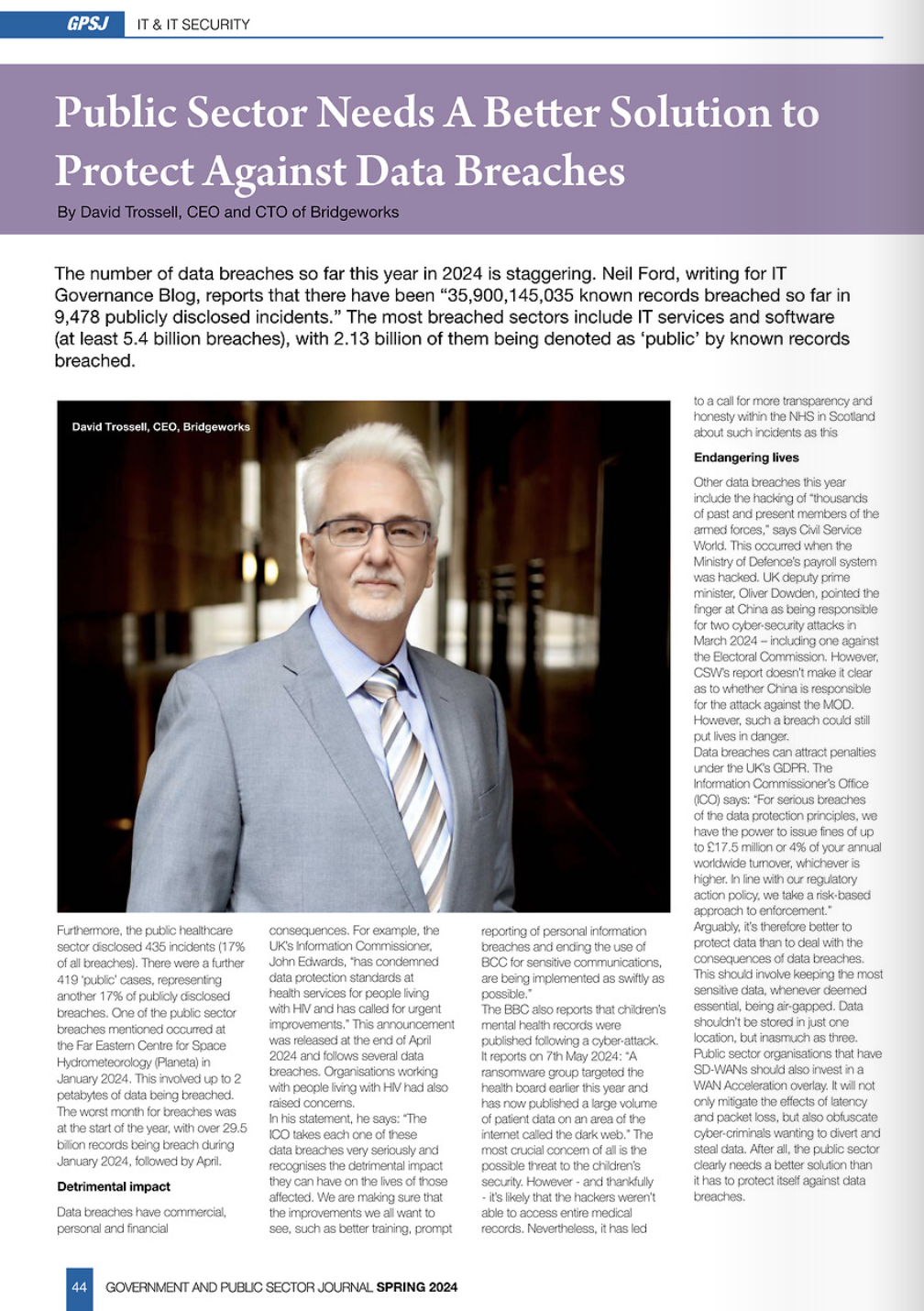Bridgeworks features in the Spring Issue of Data Centre & Network News to discuss emerging Cloud-First strategies.

Spring 2024
SD-WANs are increasingly the solution of choice for addressing WAN issues such as latency and packet loss. They emerged in the early 2010s to improve application performance at a lower cost than MPLS, and they became particularly popular during the COVID-19 pandemic when enterprises needed to connect a mixture of office and remote workers to company resources.
There is now a new paradigm shift towards Network-as-a-Service (NaaS). This is a subscription-based cloud model that moves away from individual offerings to a more comprehensive model. Enterprises rent network infrastructure components – from hardware to software and management tools from a provider. This can include compute, storage, remote management, remote monitoring, and networking. NaaS can also include hybrid clouds, on-premise cloud and edge environments.
Completing the cloud picture
David Trossell, CEO and CTO of Bridgeworks, says in recent times and, to a certain extent pushed by the Covid-19 pandemic, there has been an “if on doubt, put it in the cloud” attitude. This mentality saved all the hassle of specifying new equipment, purchasing RFP and installation, etc. NaaS and – more recently SASE – security as access service edge – complete the cloud picture.
Deanna Darah, Associate Site Editor at Techtarget, explains: “According to “2023 State of Network Edge Survey”,- sponsored by Graphiant and conducted by Eleven Research,- enterprises are looking to move from SD-WAN to NaaS to support the evolving needs of the network edge. While SD-WAN enables enterprises to manage WAN performance more efficiently, it can’t always handle modern network needs in terms of agility, scalability and cost, according to the survey. Of the 200 network architects and administrators surveyed, almost 90% said they’re interested in implementing NaaS.”
This doesn’t mean that SD-WANs are dead. Far from it, NaaS will lead to more managed SD-WAN services, and most Network-as-a-Service offerings include SD-WANs anyway. What that does mean is that SD-WANs will be offered alongside other network services. Adding to this is the fact that VMWare wants to “erase the lines between datacenter, cloud and edge.”
VMWare’s Mark Lohmeyer, Senior Vice-President and General Manager of Cloud Infrastructure, suggests this is all about following where organisations are going in Jeffrey Burt’s TheNextPlatform article on the topic of 30th August 2022. He says customers are looking to adopt multi-cloud across their data centres, public, cloud and edge environments. The key driver is the need for flexibility to build and run the right application in the right location.
The basis is customers’ technical and business requirements. To address them, it’s essential to enable “core enterprise class storage, networking, and management capabilities that support the most enterprise grade applications around the world.” To this end, VMWare believes it’s enabling a consistent infrastructure service across its customers’ existing data centres and private cloud environments, as well as across major public clouds, edge and distributed environments.
Cloud driving SD-WANs
Cloud computing is also one of the drivers for SD-WAN, NaaS, and Datacentre-as-a-Service (DaaS) growth. However, these technologies could benefit from WAN Acceleration. It can provide organisations with the flexibility to do more with their data across longer distances, while improving backup and recovery to ensure that it can obfuscate cyber-attacks because of the encryption used, the speed and efficiency of data transfer. Moreover, with latency and packet loss often causing mischief, organisations can improve their cloud application performance and bandwidth utilisation.
Like an increasing array of technologies these days, WAN Acceleration uses artificial intelligence and machine learning. It also uses data parallelisation. It’s unique to the point that if an organisation has SD-WANs – perhaps as part of a NaaS strategy – they could bolster them by deploying a WAN Acceleration overlay onto them.
Trossell explains: “For the user that wants to shy away from the cloud and traditional MPLS circuits, SD-WAN has massive cost and performance benefits. However, the idea that it can reduce latency and packet loss is a bit of a misnomer. Latency can only be reduced by moving the two end points closer together or selecting a route that has a more direct route with fewer hops.”
“Where once it was between sites and/or the cloud, it is now cloud direct to the user, and with the cloud global presence, we no longer need SD-WANs for the more remote users, since the point of presence is much closer than ever before.”
He adds that WAN Acceleration overlays are essential because SD-WANs can’t change the impact of latency and packet loss by themselves. “For large data set transmissions over long distances, SD-WANs will never reach the full performance of the underlying WAN,” he claims before underlining the need for other technologies, such as WAN Acceleration to mitigate the effects of latency and packet loss. “For critical data transfers, such as backups and for air-gapped offsite depositories, this can be a major advantage,” he suggests.
Accelerating TCP/IP traffic
So, given that many organisations are looking to maintain and adopt a cloud-first strategy, how can WAN Acceleration fit into the Network-as-a-Service model, and how different is NaaS to Infrastructure-as-a-Service? Trossell says SD-WANs are regarded as book-end solutions because one is required at both or all sites. The same applies to WAN Acceleration insofar as it relates to SD-WANs.
Trossell explains: “The WAN Acceleration technology accelerates the TCP/IP traffic over the SD-WAN by mitigating the latency and the packet losses using AI. Thus, it makes the full use of the SD-WAN capabilities as well as maximising the to the full extent the bandwidth capability of the WAN.”
WAN Acceleration could fit into a large NaaS with SD-WANs where large remote data sets are ingested, such as required for AI and organisations could benefit from faster data and network performance. Megaport’s blog explains the difference between NaaS and IaaS: “Network as a Service (NaaS) is a solution that combines IaaS with network and security services like unified threat management (UTM) and load balancing. For anyone who might already be confused, NaaS is simply IaaS minus compute and storage. As its name suggests, it is for networking only, and networking functionality is delivered via the cloud.”
Understanding networks
To ensure that organisations deploy the right technologies for their cloud-first strategies, they should first of all take time to understand their network infrastructure. Integrated Research explains: “Network managers need to familiarise themselves with the Open Systems Interconnection model OSI model, which provides a framework for understanding how data flows through a network.”
To do this it would be wise to undertake a proof-of-concept before buying into any technology, and to compare it against other solutions that claimed to either reduce or mitigate latency. This will arm IT teams and the IT C-suite with knowledge of what works best for their organisation. It will enable them to also develop a management plan to meet the business needs of their enterprise.
It’s also essential to understand security and compliance requirements. Does data need to be encrypted in transit between clouds? If it does, then WAN Optimisation is not the right solution. WAN Acceleration can achieve that in contrast to it and enable compliance with data protection regulations. With WAN Acceleration, manpower resources can be freed up because of its use of artificial intelligence and machine learning, which allow it to monitor network performance. This technology can also be part of a disaster recovery plan, as it significantly improves recovery time objectives (RTO) and recovery point objectives (RPO) – offering substantial benefits to any cloud-first strategy.
Click here to read the article on pg 63 in Data Centre & Network News.




